Soft-shell crabs have a mysterious cult-like following. Every spring, fanatics come out of hibernation to get their fill of these unique crustaceans. When deep-fried soft-shell crabs start popping up on menus all along the Atlantic coast, everyone knows spring is in full force.
Also nicknamed “soft-shells” or “softies,” soft-shell crabs are equal parts weird and fascinating. Their wrinkled paper-thin shells almost make them look fake. Yet, so many people enjoy their delicate, sweet flavor and hop on board the soft-shell craze every year.
If you are not a seasoned soft-sheller, you might have concerns when you see a whole deep-fried crab in front of you. Maybe you’ve even somehow missed the buzz on these strange creatures and don’t know much about them. You might be asking, “How do I cook soft shells, and can I eat the whole thing?” We are here to quell all your confusion. To get the scoop on these alluring crustaceans, we spoke to Max Harvey, co-owner and vice president of Wulf’s Fish in Boston, Massachusetts. As a longtime fishmonger, Harvey is no stranger to the soft-shell crab phenomenon. He helps us answer all your biggest questions about soft-shell crabs.
What are soft-shell crabs?

People sometimes mistakenly think soft-shell crabs are their own species, but they are simply crabs that have recently molted and shed their hard outer shell (via The Baltimore Sun). The new shells harden in hours, leaving a small window to harvest these crabs in their soft-shell form.
Like any crustacean, all crabs molt, but only blue crabs are commercially sold as soft shells in the United States. Although found along the Atlantic coast and the Gulf of Mexico, blue crabs are probably most known as a Maryland specialty. According to Max Harvey, blue crabs have certain characteristics that make harvesting them a worthwhile venture compared to other crustaceans. Blue crabs are, “More easily attainable in volume, and the industry has pinpointed how to predict when they will molt,” Harvey notes. They also have lots of meat on their bodies, giving them an appealing experience.
Soft-shell crabs are not unique to the United States, however. Italy has a long-standing tradition of harvesting soft shells, but they are a completely different species. A Venetian specialty, “moeche” are molted green crab, a native European species (via Slow Food Foundation for Biodiversity). Harvey expounds that the rising U.S. green crab industry is trying to break into the soft-shell market. Green crabs are an invasive species that has been decimating other local sea life from eelgrass to Dungeness crab (via NOAA Fisheries). A few U.S. harvesters are experimenting with harvesting soft-shell green crabs, but none are commercially available yet (via Greencrab.org).
How are soft-shell crabs harvested?
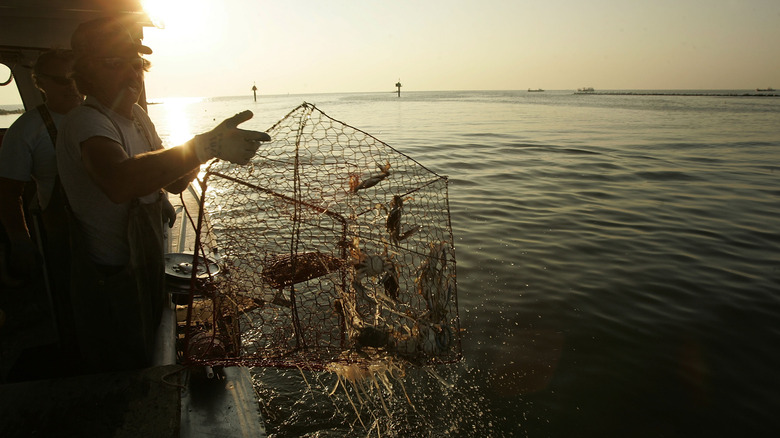
Max Harvey explained the complicated process of harvesting soft-shell crabs. For hard shells, crab fishers can drop their nets and traps, called “pots,” and then they sell the live crabs they capture. In the case of blue crabs, those hard-shell crustaceans just might end up steamed and spilled onto paper-lined tables in a traditional Chesapeake-style crab feast. Don’t forget the Old Bay spice sprinkled on top.
For soft shells, crabbers have to take extra steps to ensure the crabs are harvested at the right time. They cannot forage the ocean looking for crabs that have just molted. Instead, they harvest crabs as normal and keep them in saltwater tanks where they can monitor their progress. The harvesters have to rely on their own observation to determine when the crabs start peeling. When crabs have molted, they are taken out of the tanks to be handled and packed. Because this whole process relies on nature taking its course, it is almost impossible for crab fishers to plan when they will have crabs to sell.
The other difficulty, according to Harvey, is that when crabs molt, they are “extremely fragile.” When handled almost immediately after molting, many soft shells do not make it to their destination alive. Crabbers often let the shells harden just a little before processing so that they won’t die. They have to be careful, however, not to wait too long, or the shells will become too crunchy to enjoy eating.
Where to buy soft-shell crabs
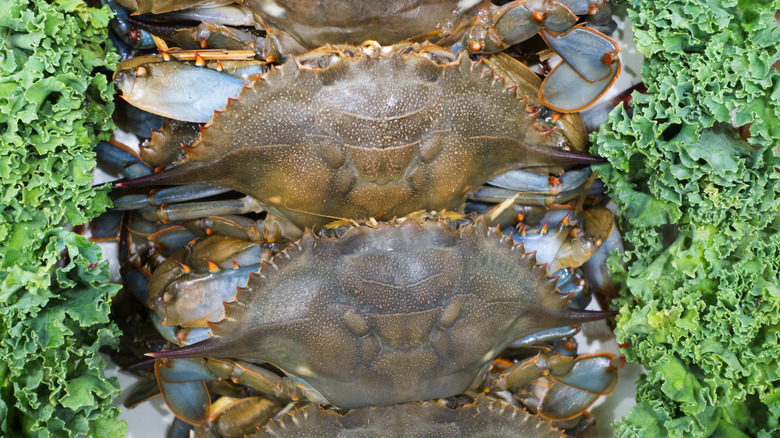
When in season, soft-shell crabs are readily available at local seafood markets and sometimes even major supermarket chains. They are sold either live or “dressed.” Live soft shells should be kept alive until ready to cook, while “dressed” ones (meaning they are killed and cleaned) are ready to cook without the extra hassle of having to butcher the crabs yourself. Fresh soft-shell crabs are an incredibly time-sensitive ingredient. Locals Seafood recommends buying soft-shell crabs the day you plan to cook them, as both live and dressed crabs can only last one to two days at most in your fridge.
Given the short shelf life of fresh crabs, frozen soft shells may be a great alternative for those who want to try these crustaceans but can’t easily access live ones. A handful of seafood companies now sell frozen soft-shell crabs and will ship them all over the country, including to inland areas that don’t often get much fresh seafood. Harvey supports the process of flash-freezing soft-shell crabs at their peak quality. He explains, “Freezing extends their shelf life, but it also elongates the season past their typical availability.”
When can you buy soft-shell crabs?
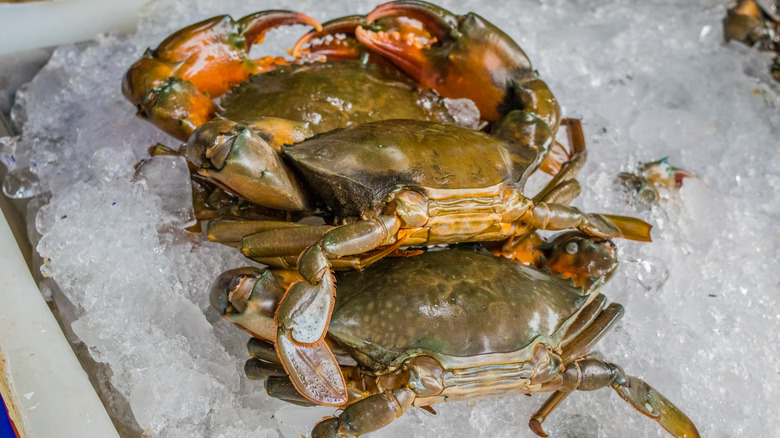
Pooh and ball/Shutterstock
While advancements in food technology have made it so you could, in theory, buy soft-shell crabs all year round, they are going to be most readily available when they are in the harvest season.
Soft-shell crab season runs from late spring through the summer (via National Geographic). According to Harvey, “The first soft-shells of the year appear as early as mid-April, but generally by the beginning of May at the latest. The season hits its peak in June and then starts to decline. By the end of July, the season has generally come to an end.” While there are still crabs available in August and September in some places, they are much rarer.
Folklore has long claimed that crabs molt in sync with the moon phases, but that is just an old wives’ tale. Harvey instead explains how the molting is related to ocean temperatures. When the ocean waters warm, the crabs start to molt. The season begins down in Louisiana and Florida (where the temperature rises first) and then travels from Georgia up the Atlantic coast. Because the crabs’ molting period starts at different times based on location, the season lasts longer than the typical six-to-8-week molting period.
How to clean and prepare soft-shell crabs
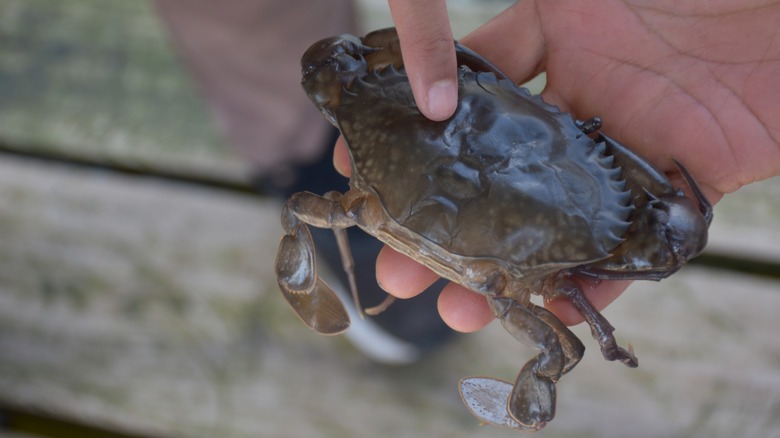
Before cooking soft-shell crabs, you must clean them. This process is also called dressing. Although it is just a few steps, you might not be up for cleaning these crabs yourself if you are at all squeamish. Remember that these are live animals.
Chef Lawrence Edelman of the Mermaid Inn gives a quick demonstration on preparing soft-shell crabs. To clean the live soft shells, first, tear off the abdominal covering, called the apron. Then, remove the feathery gills (the lungs). Finally, take your kitchen shears and cut off their face and tail, and they are all ready for cooking. Harvey agrees that this is the preferred way to enjoy these sea creatures. “They are best when truly soft,” when you can pull them right out of the ocean after molting and cook them right away. Since most people can’t harvest their own crabs, however, the frozen options are a great choice, as they are packed at their peak freshness. Plus, they are cleaned, meaning you won’t have to take scissors to them.
How to cook soft-shell crabs

Throughout the season, fried soft-shell crabs will appear on more restaurant menus than you can count, especially in the mid-Atlantic region. Chefs love to attempt individuality when it comes to their menus, but one thing most all have in common when it comes to soft-shell crabs: They will probably be fried.
If you talk to any chef or crab connoisseur, they will tell you the correct way to enjoy soft-shell crabs is to fry them. Harvey agrees with this notion. No stranger to cooking seafood, Harvey was formerly a chef at Jasper White’s Summer Shack in Cambridge, Massachusetts before devoting his life completely to the seafood industry. He affirms, “The best way to cook soft shells is to pan-sear them.” He prefers pan-frying, but others like them deep-fried. Harvey recommends coating the crabs with flour before searing them in a hot pan. This will give the crabs their characteristic crunch and leave their delicate flavor intact.
Like Harvey, The Ordinary’s Chef Mike Lata thinks soft shells should not be fussed with too much. His pan-fried soft-shell crabs are dredged in Old Bay seasoned corn meal before he gently cooks them in copious amounts of bubbling butter until they are golden brown. The chance for creativity comes from the accompanying ingredients. Lata serves his soft shells with an herb-and-radish salad and a briny tartar sauce.
Can you eat the whole shell?
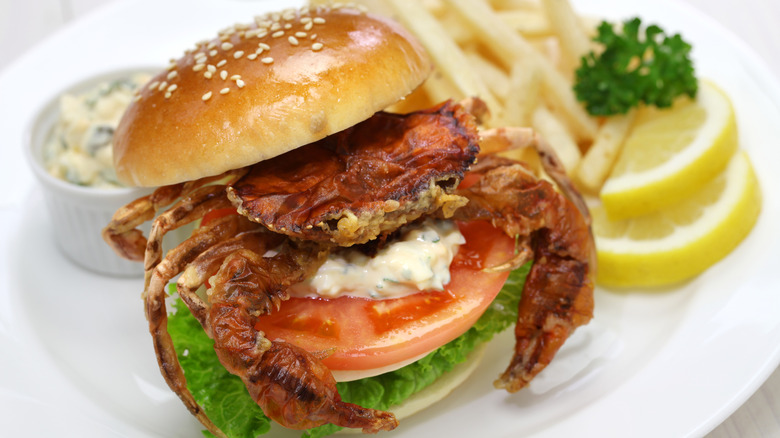
The most arduous part about eating crustaceans is having to crack open the shells to get to the juicy meat. It’s counterintuitive to see an entire crab on your plate without receiving any tools like crackers or hammers, leaving many first-time consumers hesitant to dig their teeth into them. That doubt sets in for so many as they ask themselves, “Can I really eat this whole thing?”
Essentially, yes. The entire soft-shell crab is edible, minus a couple of small parts. They do need to be cleaned first. The gills, abdomen, mouth, and tail should all be removed before cooking. These parts of the crab would not be pleasant to eat. Other than that, you can chow down on the entire creature, legs and all. Since the whole cavity is edible, they are most often served whole. That’s one of the biggest appeals of soft-shell crabs. They are a great way to enjoy blue crab meat without having to work so hard for your meal.
If you are eating soft shells at a restaurant, it is safe to assume the chefs have properly prepared the crabs and you can eat everything you were served. When preparing at home, you’ll want to double-check that all the necessary parts have been discarded. Fresh and frozen soft shells that have already been killed should be sold dressed, but you’ll want to confirm for yourself. For live crabs, you will need to clean them yourself just before cooking.
What do soft-shell crabs taste like?
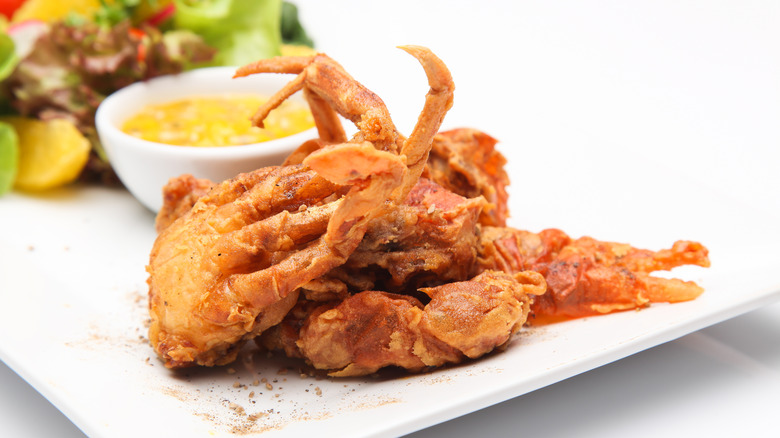
If you are familiar with blue crabs, you should have somewhat of a sense of what to expect with soft-shell crabs. Among the meatiest of crabs, blue crabs are known for their briny ocean-like taste with notes of sweetness. Soft-shell blue crabs will have similar qualities, but the flavor will seem milder because you are eating the shell and most often also a seasoned flour or cornmeal coating (via Chef’s Resources). What you are tasting is not just the pure flavor of the crab meat.
Although milder in flavor, soft-shell crabs give a more complex eating experience. You’ll still experience the tender, buttery meat you love from blue crab but with a slight crunch. The shell creates varying textures in every bite. Harvey also explains how soft-shell crabs have a more intricate character than their hard-shell versions, “The liver adds a hint of umami that you might miss out on when eating the meat alone.”
Nutritional info for soft-shell crab
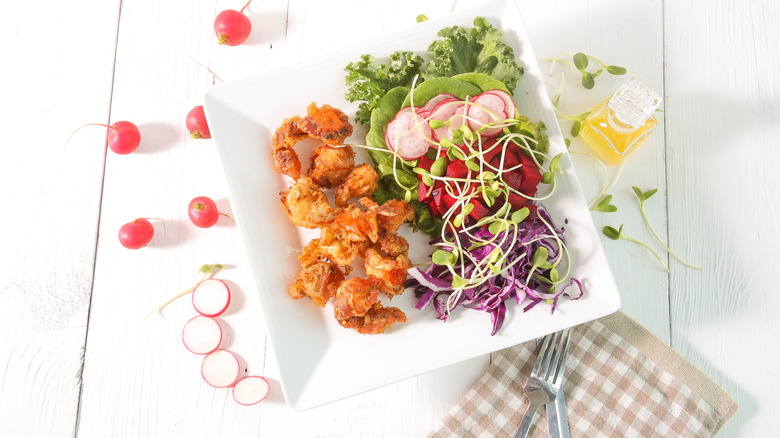
On average, a pound of whole blue crabs will provide 2 ¼ ounces of picked meat (via the University of Florida). A 100-gram portion of cooked meat contains 83 calories, 18 grams of protein, 395 milligrams of sodium, and less than 1 gram of fat (via USDA). It has no carbohydrates or sugar and is considered a good source of calcium, phosphorus, zinc, copper, iron, and potassium.
Since soft-shell crabs involve eating more than just meat, their nutritional make-up looks a little different. According to the USDA, a 100-gram serving of coated and fried soft-shell crab has 223 calories, 11 grams of fat, 10 grams of carbohydrates, and 693 milligrams of sodium. Each serving does still contain 18 grams of protein, but breading and frying the crabs in oil adds additional calories, fat, and carbs. However, fried soft-shell crabs do maintain several useful nutrients. Per serving, you get 112 grams of calcium, which is about 11% of the daily recommended value. It also supplies 1.3 milligrams of iron, 39 milligrams of magnesium, 250 milligrams of phosphorus, and 271 milligrams of potassium.
Both shelled meat and fried soft-shell crabs are fairly high in cholesterol at 97 milligrams and 122 milligrams respectively. As cholesterol has been associated with an increased risk for heart disease, the daily recommended limit is 300 milligrams per day or 200 milligrams for people with other known risk factors for heart disease (via the University of California at San Francisco Health).
Soft-shell crab recipes

A classic breading and frying of soft-shell crabs is all it takes to enjoy this seasonal treat. However, creativity and flare come from the overall flavor profile of your dish. The accompaniments can balance out the simplicity of the fried crabs. Since there are so many recipes out there, make sure to choose the ones that match your tastes.
In our adaptation of Mike Lata’s soft-shell crabs with radish salad, the crabs are coated in Old Bay-spiked cornmeal and pan-fried in butter. They are served with a bright herb-and-radish salad with briny notes from cornichons that pairs well with the natural saline flavor of the crab. Another strong contender is our recipe for pan-fried soft-shell crabs with cucumber-yuzu vinaigrette and butter lettuce salad. For this application, we pan-fry the crabs without any coating, letting their flavor shine on its own. The citrusy cucumber salad and crabs come together to form refreshing lettuce cups.
For soft-shell crabs, you can go subtle or bold. Just try not to choose accompaniments that will overpower the delicate flavor of the crab. Instead, pick flavors and dishes that will complement the salty, savory crab.







